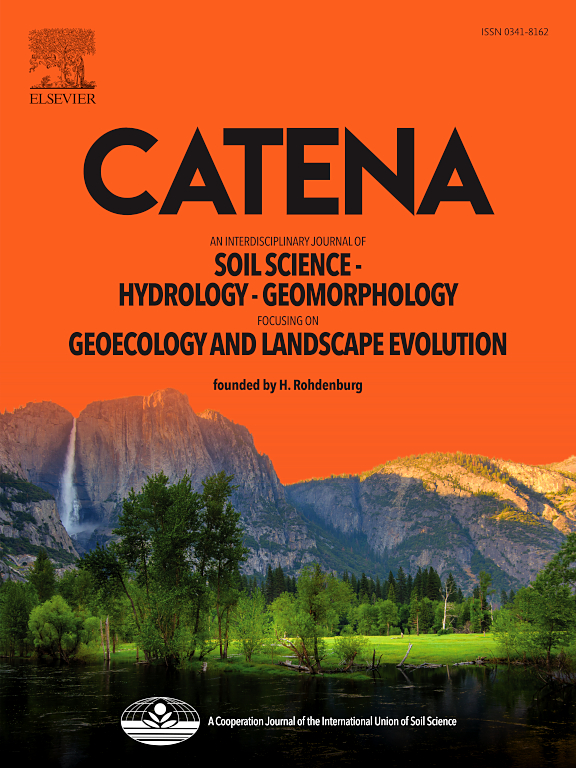Variations in soil organic C stocks, sources, and composition during the development of Larix principis-rupprechtii plantations: Evidence from spectroscopic, microbial, and lignin analyses
IF 5.4
1区 农林科学
Q1 GEOSCIENCES, MULTIDISCIPLINARY
引用次数: 0
Abstract
Afforestation has been recognized as an effective strategy for enhancing Soil Organic C (SOC) and mitigating climate change. Yet, the temporal dynamics of SOC quantity, quality, and origins, along with the mechanisms driving these changes during stand development, remain inadequately understood. To address this knowledge gap, five Larix principis-rupprechtii plantations of varying ages (7, 18, 25, 34, and 44 yr.) were selected to elucidate the temporal variations in SOC characteristics following reforestation, based on 13C-nuclear magnetic resonance, phospholipid fatty acid, eco-enzymatic activity, microbial necromass, and lignin phenols analysis, etc. Results showed that with increasing stand ages, SOC, Plant-derived C (PC), microbial-derived C (MNC), hydrolytic eco-enzymatic activities, and microbial biomass initially increased and subsequently decreased, with most parameters peaking in 25 yr. stand. Notably, the increased stand ages (i.e., 34 and 44 yr.) or soil depths (20 − 40 cm) enhanced SOC stability, as well as enlarged MNC but reduced PC contribution to SOC. Besides, the reduced syringyl/vanillyl values and elevated their acid/aldehyde ratios in 34 and 44 yr. stands (or 20 − 40 cm depths) indicated that an increased degree of lignin microbial oxidation and decomposition with increasing stand ages or soil depths. Random forest model revealed that biotic and abiotic factors (i.e., hydrolytic eco-enzymatic activity, bulk density, Total N (TN), and SOC stability), rather than litter properties, were the primary factors controlling the PC. The MNC, however, was mainly influenced by litter biomass, TN, SOC/TN, and hydrolytic eco-enzymatic activity. Partial least squares path models partially corroborated these findings and highlighted the synergistic effect of plant- and microbial-derived C on long-term SOC stocks. Concluding, these findings provided new insights into the mechanisms underlying SOC formation/characteristics during forest development, and offer a theoretical basis for sustainable development of forests in northern China from the perspective of soil C sequestration.
华北落叶松人工林发展过程中土壤有机碳储量、来源和组成的变化:来自光谱、微生物和木质素分析的证据
植树造林已被认为是提高土壤有机碳(SOC)和减缓气候变化的有效策略。然而,在林分发育过程中,SOC的数量、质量和来源的时间动态以及驱动这些变化的机制仍未得到充分的了解。为了解决这一知识空白,选择5个不同树龄(7、18、25、34和44年)的华北落叶松人工林,基于13c -核磁共振、磷脂脂肪酸、生态酶活性、微生物坏死块和木质素酚分析等,阐明了造林后土壤有机碳特征的时间变化。结果表明:随着林龄的增加,土壤有机碳(SOC)、植物源碳(PC)、微生物源碳(MNC)、水解生态酶活性和微生物生物量呈先上升后下降的趋势,其中大部分参数在林龄25年时达到峰值;值得注意的是,林龄(34年和44年)和土壤深度(20 ~ 40 cm)的增加增加了土壤有机碳的稳定性,增加了MNC,但降低了PC对有机碳的贡献。此外,34年和44年林龄(20 ~ 40 cm深度)的丁香基/香兰基值降低,酸/醛比升高,表明木质素微生物氧化和分解程度随着林龄和土壤深度的增加而增加。随机森林模型显示,生物和非生物因子(即水解生态酶活性、容重、总氮(TN)和有机碳稳定性)是控制生物量的主要因素,而不是凋落物性质。MNC主要受凋落物生物量、全氮、有机碳/全氮和水解生态酶活性的影响。偏最小二乘路径模型部分证实了这些发现,并强调了植物和微生物来源的碳对长期有机碳储量的协同效应。综上所述,这些研究结果为森林发展过程中有机碳的形成机制和特征提供了新的认识,并从土壤碳固存的角度为中国北方森林的可持续发展提供了理论依据。
本文章由计算机程序翻译,如有差异,请以英文原文为准。
求助全文
约1分钟内获得全文
求助全文
来源期刊

Catena
环境科学-地球科学综合
CiteScore
10.50
自引率
9.70%
发文量
816
审稿时长
54 days
期刊介绍:
Catena publishes papers describing original field and laboratory investigations and reviews on geoecology and landscape evolution with emphasis on interdisciplinary aspects of soil science, hydrology and geomorphology. It aims to disseminate new knowledge and foster better understanding of the physical environment, of evolutionary sequences that have resulted in past and current landscapes, and of the natural processes that are likely to determine the fate of our terrestrial environment.
Papers within any one of the above topics are welcome provided they are of sufficiently wide interest and relevance.
 求助内容:
求助内容: 应助结果提醒方式:
应助结果提醒方式:


